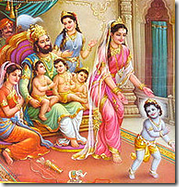 “The most fortunate Kausalya looks charming as she sits on the beautiful bedstead holding the child Rama in her lap. Gazing upon His moon-like face again and again, she makes her eyes like a Chakora bird to His form.” (Gitavali, 7.1)
“The most fortunate Kausalya looks charming as she sits on the beautiful bedstead holding the child Rama in her lap. Gazing upon His moon-like face again and again, she makes her eyes like a Chakora bird to His form.” (Gitavali, 7.1)
subhaga seja sobhita kausilyā rucira rāma-sisu goda liye |
bāra-bāra bidhubadana bilokati locana cāru cakora kiye ||
Rama Navami celebrates the appearance day of Lord
Ramachandra, the delight of the Raghu dynasty, who has a moon-like countenance to please the Chakora-like
devotees, who never tire of gazing upon His beautiful face, which wears an enchanting smile and gives off a soothing radiance that douses the fire of material suffering. In fact, it is the association with the divine that is the
only remedy for all ills, for the root of pain and misery is forgetfulness of that supremely fortunate person, who holds every opulence at the same time and to the fullest degree; hence one of His many names is Bhagavan.
In general social etiquette, it is not polite to stare at others. The reason for this should be quite obvious. Would you like it if someone else was looking at you all the time? Perhaps you wouldn’t mind the attention if the sentiment was positive, but after a while, the instinctual reaction would be, “Hey man, quit looking at me! Can I help you with something?” Indeed, the gawking husband has been the painful burden of the devoted wife for ages, as the man can’t help but try to assess the attractiveness of another female when he first sees her. Of course this is very rude behavior towards the wife, for the desire to look at another woman indicates that the man might not be pleased with whom he has for a life partner.

One sneaky way to get around the impoliteness of staring is to find situations where the person being looked at either doesn’t know what you are doing or is powerless to stop you. Thankfully for us, the creator made one situation which is favorable for staring and which also doesn’t violate any common standards of decency. The young child, especially the dependent, can be looked at nonstop, especially if they are really new to this world. Their vision can be so enchanting, making you really believe in a higher power, for how else to explain such innocence placed into a tiny bundle of joy? For a mother a long time ago, she couldn’t help but stare at her newborn. To make the situation that much more auspicious, the delight she held in her lap was the honoree of the soon-to-be instituted tradition of Rama Navami.
During a period of time in the Treta Yuga, King Dasharatha was at the helm of Raghu’s clan, the dynasty of kings originating with King Ikshvaku and which subsequently had the good fortune of including King Raghu as one of its members. The descendants in that line were thus often referred to as Raghava. A key for rulers in this family was to keep it going. If you have a famous family that is known for its ability to protect the citizens, to give them proper guidance in all matters of life and to keep out the influence of sin and vice, including that which comes from foreign attack, it’s important to keep that line of succession going. This way the citizens won’t have to worry when the king gets old. They can rest assured knowing that he will pass on his good reputation and character to his heir.
This was the problem for Dasharatha. He had no sons to whom to pass down the kingdom. After consulting with his royal priests, it was decided that a sacrifice would be held. The queens would eat the remnants of that sacrifice, and from that sanctified food they would become pregnant with child. Sure enough, everything went according to plan, except no one could predict the beauty and grace of the four children. The four sons born to Dasharatha were expansions of
Lord Vishnu, the Supreme Personality of Godhead in His opulently adorned, four-handed form.

The eldest Rama was Vishnu Himself, and the three younger brothers were partial expansions. Queen Kausalya gave birth to Rama, Kaikeyi to Bharata, and Sumitra to
Lakshmana and Shatrughna. The children were a delight for their mothers, and Rama was especially enchanting to everyone, including Dasharatha. There is much attention paid when a new child is born, and since these boys were to be successors in the ancestral line, there was even more celebration when they took birth.
Brahmanas were fed,
cows were milked, and gifts were distributed quite liberally by the king. The townspeople felt as if the four boys were their own children, so they showed up to the royal palace with so many gifts. They also decorated their homes very nicely, creating auspiciousness all around. Whenever the Supreme Lord personally appears, there is automatically an auspicious condition, but these residents had pure love, so they didn’t take anything for granted. They prayed for the welfare of the four sons, that they would grow up to be brave, strong, pious, and just as dedicated to the welfare of all as Dasharatha.
Queen Kausalya had a special benefit, for she got to spend time with Rama alone. In those quiet moments, she got to stare at her young child, and there was nothing He could do about it. As one gets a little older, the smothering attention from the mother can become a bother. The child doesn’t know any better, as they can’t understand at such a young age what type of attachment the mother has formed with them. In the infant years, though, the child can only pleasantly smile in return when the mother constantly stares at them.
In the above referenced verse from the
Gitavali of Goswami
Tulsidas, we see that Dasharatha’s chief queen looked especially charming when seated on her wonderful bedstead. She held the Supreme Lord in her lap, for she earned His company from pious acts performed in previous lives. Can we imagine the happiness she felt? The most beautiful person in the world lay in her lap in a form that required motherly affection. He was in front of her in a special form that best brought out spontaneous, parental affection, loving feelings that were not inhibited in any way.

Of course to try to understand Kausalya’s feelings at the time is a little difficult, so the kind poet gives us some help. He says that she made her eyes like those of the Chakora bird, which constantly stares at the moon. The Chakora has a pure love for the moon, for it looks constantly at the bright luminous body in the dark sky and doesn’t ask for anything in return. No other light gives it as much happiness, and when that moon is gone, there is no source of happiness that can replace it.
In a similar manner, Queen Kausalya’s only source of pleasure was Rama, and because of this she was considered most fortunate, or subhaga. How can she be described in any other way? Where we get our primary pleasure is what will determine how fortunate or unfortunate we are. The drunkard worships the bottle of whiskey and thus finds only distress amidst illusory and temporary elation. The gambler worships the game and the next roll of the dice, and the sensually stirred person hangs on the next move of their significant other, not realizing that the same type of pleasure is already available to the less intelligent animals. The voracious meat eater takes their pleasure from the flesh of animals that were needlessly killed.
Because these sources are not pure, those taking their primary pleasure from them will be in unfortunate circumstances. On the other hand, one who finds pleasure from the person who is the most fortunate, Bhagavan, can in many ways be considered more fortunate than God Himself.
Lord Rama has the company of His devotees and His pleasure potency expansions like
Sita Devi, but the Chakora-like devotees have the association of both Shri Rama and His associates. As they depend only upon Rama and His every move for their happiness, they are never bereft of the pleasure that is every person’s birthright.
On Rama Navami, we celebrate that very fortunate queen, who would love her son for the rest of her life. He would have to leave her company several times when He got older, but never did He leave her heart. She constantly gazed upon His moon-like face, and not at any time was the behavior impolite. On the contrary, the Chakora-like devotees know that devotion is the only auspicious path, and that through following it Rama will never abandon them, either in this life or the next.
In Closing:
In common circumstances impolite to stare,
To look at someone for too long we don’t dare.
In one situation that behavior is actually fine,
To stare at newborn, they are too young to mind.
Shri Rama created this for His loving mother,
She stared at Him in her quiet room, for God no bother.
So adorable was the Supreme Lord in the small size,
That mother like a Chakora bird made her eyes.
On Rama Navami the mother and son we celebrate,
To Lord and devotee’s pleasure this life we dedicate.
 “The most fortunate Kausalya looks charming as she sits on the beautiful bedstead holding the child Rama in her lap. Gazing upon His moon-like face again and again, she makes her eyes like a Chakora bird to His form.” (Gitavali, 7.1)
“The most fortunate Kausalya looks charming as she sits on the beautiful bedstead holding the child Rama in her lap. Gazing upon His moon-like face again and again, she makes her eyes like a Chakora bird to His form.” (Gitavali, 7.1) One sneaky way to get around the impoliteness of staring is to find situations where the person being looked at either doesn’t know what you are doing or is powerless to stop you. Thankfully for us, the creator made one situation which is favorable for staring and which also doesn’t violate any common standards of decency. The young child, especially the dependent, can be looked at nonstop, especially if they are really new to this world. Their vision can be so enchanting, making you really believe in a higher power, for how else to explain such innocence placed into a tiny bundle of joy? For a mother a long time ago, she couldn’t help but stare at her newborn. To make the situation that much more auspicious, the delight she held in her lap was the honoree of the soon-to-be instituted tradition of Rama Navami.
One sneaky way to get around the impoliteness of staring is to find situations where the person being looked at either doesn’t know what you are doing or is powerless to stop you. Thankfully for us, the creator made one situation which is favorable for staring and which also doesn’t violate any common standards of decency. The young child, especially the dependent, can be looked at nonstop, especially if they are really new to this world. Their vision can be so enchanting, making you really believe in a higher power, for how else to explain such innocence placed into a tiny bundle of joy? For a mother a long time ago, she couldn’t help but stare at her newborn. To make the situation that much more auspicious, the delight she held in her lap was the honoree of the soon-to-be instituted tradition of Rama Navami. The eldest Rama was Vishnu Himself, and the three younger brothers were partial expansions. Queen Kausalya gave birth to Rama, Kaikeyi to Bharata, and Sumitra to
The eldest Rama was Vishnu Himself, and the three younger brothers were partial expansions. Queen Kausalya gave birth to Rama, Kaikeyi to Bharata, and Sumitra to  Of course to try to understand Kausalya’s feelings at the time is a little difficult, so the kind poet gives us some help. He says that she made her eyes like those of the Chakora bird, which constantly stares at the moon. The Chakora has a pure love for the moon, for it looks constantly at the bright luminous body in the dark sky and doesn’t ask for anything in return. No other light gives it as much happiness, and when that moon is gone, there is no source of happiness that can replace it.
Of course to try to understand Kausalya’s feelings at the time is a little difficult, so the kind poet gives us some help. He says that she made her eyes like those of the Chakora bird, which constantly stares at the moon. The Chakora has a pure love for the moon, for it looks constantly at the bright luminous body in the dark sky and doesn’t ask for anything in return. No other light gives it as much happiness, and when that moon is gone, there is no source of happiness that can replace it. “While the ladies of the capital of Hastinapura were greeting Him and talking in this way, the Lord, smiling, accepted their good greetings, and casting the grace of His glance over them, He departed from the city.” (Shrimad Bhagavatam, 1.10.31)
“While the ladies of the capital of Hastinapura were greeting Him and talking in this way, the Lord, smiling, accepted their good greetings, and casting the grace of His glance over them, He departed from the city.” (Shrimad Bhagavatam, 1.10.31) Similarly, I can only hear that which is in audible range. With the help of radio and cell phone technology, I can perhaps hear more, but these require external devices. With the Supreme Lord, His consciousness pervades the entire space. He is simultaneously conscious of every single living creature’s thoughts and desires, and He remembers the thoughts of the same beings from their previous lives. The concept of
Similarly, I can only hear that which is in audible range. With the help of radio and cell phone technology, I can perhaps hear more, but these require external devices. With the Supreme Lord, His consciousness pervades the entire space. He is simultaneously conscious of every single living creature’s thoughts and desires, and He remembers the thoughts of the same beings from their previous lives. The concept of After defeating the king, Krishna released the princesses. He could have sent them back to their homes, but then no one would have married them. Who would be there to protect them afterwards? Also, they desired to have Krishna, their rescuer, as their husband. Thus the Lord obliged and treated them wonderfully, buying them gifts regularly and making them feel like they were in control of the relationship. The person whom meditational yogis and mental speculators are trying to understand and see for but one second can be commanded by those who are surrendered to Him in thought, word and deed.
After defeating the king, Krishna released the princesses. He could have sent them back to their homes, but then no one would have married them. Who would be there to protect them afterwards? Also, they desired to have Krishna, their rescuer, as their husband. Thus the Lord obliged and treated them wonderfully, buying them gifts regularly and making them feel like they were in control of the relationship. The person whom meditational yogis and mental speculators are trying to understand and see for but one second can be commanded by those who are surrendered to Him in thought, word and deed. Irrespective of His physical location, Krishna can remain in the mind through regular recitation of the holy names, “
Irrespective of His physical location, Krishna can remain in the mind through regular recitation of the holy names, “